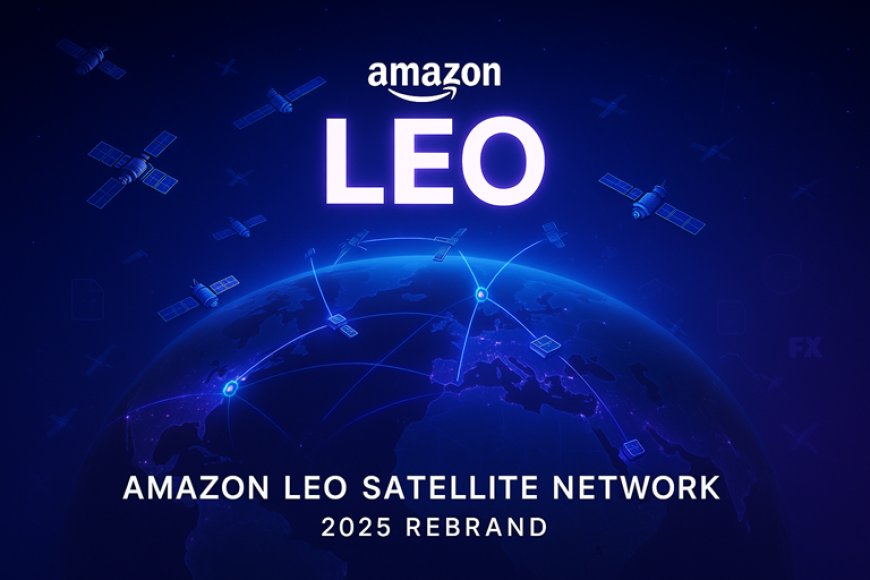Amazon Rebrands Project Kuiper to ‘Leo’ — Satellite Network Shifts to Enterprise Strategy in 2025
Amazon has rebranded Project Kuiper to “Leo,” shifting away from its affordability promise toward enterprise, aviation, defense, and commercial satellite services. Here’s what the Amazon Leo satellite network rebrand means for the industry, Starlink competition, and global connectivity in 2025.

Amazon Rebrands Its Satellite Network to ‘Leo’ — Drops Affordability Pitch in Major 2025 Strategic Shift
Amazon has officially rebranded its satellite broadband program — previously known as Project Kuiper — to a new identity: Amazon Leo. The move marks a significant strategic shift as the company steps away from its early promise of providing “affordable satellite internet for everyone.” Instead, Amazon is positioning Leo as a premium, high-performance satellite communications network built to serve enterprise customers, governments, carriers, and large-scale commercial operators.
The amazon leo satellite network rebrand 2025 upgrade is more than just a name change. The company is signaling a transition from consumer-focused ambitions toward becoming a competitive force in the global space communications industry — directly challenging rivals like SpaceX’s Starlink, OneWeb, and Telesat. By dropping affordability as a core pitch, Amazon is leaning into reliability, high bandwidth delivery, secure connectivity, and enterprise-level contracts.
🚀 From Project Kuiper to Amazon Leo — Why the Rebrand?
Originally announced in 2019, Project Kuiper was Amazon’s effort to build a massive low-earth orbit (LEO) broadband constellation. The project carried expectations of providing low-cost connectivity to underserved regions worldwide. But as development scaled and costs skyrocketed, Amazon has now repositioned the project under a new brand: Leo.
- New brand identity: Leo is intended to reflect the network’s LEO (low-Earth orbit) satellite architecture.
- Shift away from consumer internet: Amazon is no longer emphasizing low-cost home broadband.
- Enterprise-first focus: The company is targeting airlines, maritime operators, governments, and major telecom carriers.
- Global messaging refresh: Marketing for Project Kuiper was centered on affordability; Leo focuses on performance and scalability.
This transition indicates Amazon’s acknowledgement that competing on pricing with Starlink — which already dominates consumer satellite broadband — may not be strategically viable.
💼 Amazon Leo Drops the “Affordable Internet” Promise
The most significant change in strategy is Amazon’s quiet removal of its original narrative about bringing low-cost broadband to underserved populations. Company executives clarified that Leo's infrastructure is now geared toward:
- Enterprise-grade data transmission
- Defense and government-level communications
- Carrier partnerships to supplement terrestrial networks
- High-bandwidth, low-latency commercial connectivity
The amazon leo drops affordability pitch satellite internet pivot suggests Amazon is looking for sustainable revenue streams that align with high-margin commercial contracts rather than resource-heavy consumer operations.
🌍 What Amazon Leo Means for the Satellite Internet Market
The satellite broadband landscape is evolving rapidly with competition heating up. Amazon Leo is launching into a global market where companies are battling for dominance in enterprise, aviation, maritime, and government sectors.
- Starlink remains the consumer leader with millions of subscribers globally.
- OneWeb focuses on wholesale connectivity and enterprise contracts.
- Telesat aims to provide competitive LEO services for businesses and telecom operators.
In this competitive arena, Amazon’s rebrand positions Leo not as a Starlink competitor for household internet, but as a premium satellite partner for mission-critical industries.
✈️ Which Markets Will Amazon Leo Target?
Amazon’s updated strategy is heavily targeted toward commercial applications. Under the new branding, the company aims to secure contracts in:
- Aviation: in-flight broadband for airlines
- Maritime: connectivity for cargo ships, oil tankers, and cruise liners
- Government & Defense: secure communications for armed forces and public agencies
- Telecom: backhaul support for 4G/5G carriers
- Enterprise cloud: integration with AWS edge computing
This direction is reinforced by Amazon’s existing cloud infrastructure dominance — AWS — suggesting deep integration opportunities between satellite connectivity and edge computing.
📡 Amazon Leo vs Starlink — A New Competitive Phase
The amazon satellite internet network leo vs starlink 2025 rivalry will be closely watched. Amazon Leo is not competing directly in the consumer market, but there are overlapping segments where both will clash:
- Aviation and maritime broadband
- Military and government communications
- Rural enterprise connectivity
- Cloud-integrated edge networks
While Starlink has a massive head start, Amazon’s advantages include:
- Deep pockets for infrastructure investment
- AWS cloud integration
- Strong enterprise and government relationships
- Existing global logistics operations
If Amazon executes well, Leo may become a major challenger — not by matching Starlink’s consumer presence, but by dominating high-value enterprise verticals.
🛰️ Satellite Deployment Status — How Close Is Amazon Leo?
Amazon has already launched several sets of test satellites. Commercial deployment is expected to scale significantly within the next two years.
- Test satellites launched successfully in 2023 and 2024.
- More than 3,000 satellites planned for the full constellation.
- Manufacturing ramping up at Amazon’s facility in Kirkland, Washington.
- Commercial services expected to begin phased rollout by late 2025 to early 2026.
Amazon is also building ground-station partnerships around the world to support Leo’s coverage and throughput requirements.
📝 Why Amazon Dropped the Consumer Pitch
Industry analysts say the shift was inevitable. While Starlink has proven that mass-scale satellite broadband is possible, the cost of launching and maintaining thousands of satellites remains extremely high. Amazon’s leadership realized that consumer-only pricing models are difficult to sustain long-term.
“Amazon’s Leo rebrand acknowledges a clear reality: the future of satellite broadband profitability lies in enterprise and government contracts, not household subscriptions.”
By repositioning its ambitions, Amazon is aligning itself with the most lucrative part of the satellite communications market.
🌐 What This Means for Consumers
For everyday users hoping for low-cost satellite internet from Amazon, this update may come as a disappointment. Leo is no longer focused on providing home broadband services.
Instead, the company plans to partner with telecom providers who may use Leo’s network to expand rural connectivity. This means consumers might eventually get access to Amazon-powered satellite broadband — but through local carriers, not directly from Amazon.
💼 Business & Enterprise Impact
Enterprise customers stand to gain the most from Amazon Leo’s rebrand. With better integration across AWS services, global logistics capabilities, and high-value commercial applications, Amazon Leo could become a powerful alternative to existing satellite providers.
- IoT connectivity for remote facilities
- Disaster recovery networks
- Autonomous logistics coordination
- Secure enterprise cloud connection
This focus clearly places Amazon Leo in a different league from typical consumer satellite broadband networks.
❓ FAQ – Amazon Leo Satellite Network Rebrand 2025
A: It is the new brand name for Amazon’s satellite broadband initiative, previously called Project Kuiper.
Q: Why did Amazon rebrand Project Kuiper?
A: To shift its strategy toward enterprise and government markets and move away from consumer affordability messaging.
Q: Is Amazon Leo competing with Starlink?
A: Yes, but mainly in enterprise, aviation, maritime, and government sectors — not consumer broadband.
Q: Will Amazon Leo offer cheap home internet?
A: No. The new strategy focuses on commercial and industrial customers instead of consumers.
Q: When will Amazon Leo begin service?
A: Early commercial deployments are expected between late 2025 and 2026.
📚 Sources & Further Reading
- TechCrunch – Amazon Leo Rebrand Story
- Code24 – Space Tech & Satellite Network Updates
- AWS – Official Announcements
Sneak peek: With its new Leo branding and enterprise focus, Amazon is redefining its place in the satellite internet industry — setting the stage for a new era of high-performance space communications.
What's Your Reaction?
 Like
0
Like
0
 Dislike
0
Dislike
0
 Love
0
Love
0
 Funny
0
Funny
0
 Angry
0
Angry
0
 Sad
0
Sad
0
 Wow
0
Wow
0



















































